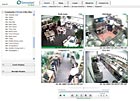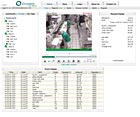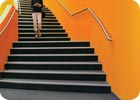Multitasking Tastes Good

A fully Web-based, hosted video surveillance service allows customers such as IHOP and Chipotle Grill to buy on a software-as-a-service subscription basis.
On a twist of a favorite barbeque cook’s slogan, the closer security systems get to the business bone, the sweeter the payoff.
Jeff Kessler, the security industry analyst at Lehman Brothers, made the point at the most recent Securing New Ground conference. From his Wall Street perch, Kessler said enterprises are already reaping significant business gains, beyond traditional security, thanks to convergence with IT, building, financial, compliance and human resources systems.
Mashoor Awad, IHOP franchisee with stores in Delaware and Maryland, shares Kessler’s view. He sought a state-of-art system that converged with point-of-sales (POS) and with remote views of backroom operations so he could better run his businesses, more safety and, by the way, more securely, too.

IHOP franchisee Mashoor Awad required a multitasking video surveillance system with remote access and convergence with point-of-sale. Backroom cameras helped bring more money to the operational bottom line.
FOCUS ACCESS UPGRADE ON BUSINESS
Isabelle Curro, deputy director of security at John Jay College of Criminal Justice, had her unique business in focus when considering an access control upgrade. The new system had to easily converge with the all-important registrar system.Dan Caruso and Matt Steinfort, two Boulder, Colo.-based MBAs, are beating the same business drum by mixing a venture capitalist mindset and telecommunication expertise with broadband video. Their company, Envysion, has a video surveillance service that enables customers with hundreds of locations to improve their operations and profitability through the use of remote video that is integrated with their key business systems. The fully Web-based, hosted service allows customers to buy on a software-as-a-service subscription basis. “We transform a customer’s video investment from an insurance policy to a key operational system with a hard dollar return on investment,” said Steinfort.
“By reviewing back room activity, I have significantly reduced shrinkage and added one percentage point to my bottom line,” observed Awad. That’s a heaping plateful to his operational bottom line.
Shrinkage, consisting of a combination of employee theft, shoplifting, administrative errors and vendor fraud, is a significant threat to the profitability of any retail business. The National Restaurant Association estimates that the losses stemming from employee theft alone amount to over $8.5 billion annually, somewhere in the area of four percent of food sales. Industry experts say that anywhere from 50 to 75 perent of inventory shortages can be traced back to employee theft.

When John Jay College of Criminal Justice needed an access control upgrade, Isabelle Curro, deputy director of security, had business goals in focus. The new system had to easily converge with all-important registrar, HR and court connect systems.
BOTTOM LINE EXPANDS
With the average IHOP generating approximately $1.7 million annual sales, that can mean $68,000 coming right off the bottom line.No company wants to believe their own employees could be stealing from the company—and the good news is that the vast majority don’t. But the small percentage of employees who are dishonest affect the livelihood and well-being of the entire company. An effective loss prevention program will incorporate five primary strategies: deterrence, control, detection, investigation, and disciplinary action/recovery. Video surveillance has a key role to play in each of these.
Awad had several requirements. The system needed to be remotely accessible so that the owner could maintain an effective presence at multiple locations and spot check employees. Integration with the POS system was also necessary to effectively monitor register activity. The system had to provide coverage of key employee and storage areas with a range of environmental and camera requirements.
Using a combination of indoor, outdoor, and specialized camera configurations, the broadband video surveillance solution was brought in. Integrating with the customer’s Micros 3700 POS system, Awad can quickly playback video of register activity associated with specific transactions. Remote monitoring was made available at all of the locations, maximizing accessibility.
RECOGNIZING PATTERNS
By regularly reviewing and spot checking employee activity, he was able to identify a regular pattern of food consumption among employees. By researching this behavior using video footage, the IHOP owner was able to effectively confront the employee behavior and deter future occurrences. Reduction in inventory loss from employee theft has had a pronounced impact on the profitability of the operation.In a much larger installation, Monty Moran, president and COO at Chipotle Mexican Grill, saw similar business value. “At Chipotle, we’re always looking for ways to better serve our customers,” said Moran. “The (broadband video) system will help us create a better environment for both our customers and our employees.”
Steinfort said his firm has been selected by the big burrito restaurant with more than 600 locations to deploy Web-based video management systems in all of Chipotle’s restaurant locations. He added that “with hundreds of employees needing access to video, Chipotle will benefit from centrally managed software that scales far beyond a traditional video system and can be incorporated into other business systems and processes.”
A business focus for security also appears at colleges and universities.
For example, just two blocks from Central Park in New York City, the John Jay School for Criminal Justice simplified its access control system in three buildings by employing an IP-based access control system (from DVTel, Ridgefield Park, N.J.) to provide security for more than 20,000 students, faculty and staff at three college buildings in New York City.
The complete “turnkey” replacement of an older system has the capability to solve the most labor-intensive problem in a university system environment: data input and assigning user privileges.
The system is able to automatically load cardholders and assign access privileges to the student, faculty and staff population via downloads from the university’s registrar, a key selling point for Curro.
There are approximately 30 turnstiles and six badging stations at the three different campus locations. The vendor provided all data conversion from the original system including photos and card information.
SIDEBAR: The IHOP Recipe
- 13-camera indoor/outdoor system
- POS integration
- Configuration for three locations
SIDEBAR: The John Jay Way
- Longitude IP Access Control – an open, software-based access control solution
- Alarm monitoring
- Graphical maps
- Automation
- Reporting
- Photo ID badge creation
- Time and attendance
- Visitor logging
- PLC for criminal courts/correctional institutions
SIDEBAR: Business Focus Still Needs Sharpening
Companies most attuned to security as a business issue are those with the most exposure to a broad range of security risks, according to a survey last year by The Conference Board, and previously reported by Security Magazine.Navigating Risk: The Business Case for Security was based on a survey of 213 senior corporate executives not specifically responsible for security or risk matters.
The surveyed companies most concerned with security are companies in critical infrastructure industries (including energy and utilities, chemicals, and transportation), large corporations, multinationals with global operations, and publicly-traded companies, according to Thomas Cavanagh, senior research associate in global corporate citizenship at The Conference Board and author of the report.
Executives were asked how effectively their company’s security was aligned with their company’s business objectives, in other words, to what extent their own company’s security operation contributes to accomplishing the firm’s overall mission in the marketplace.
The most effective alignment was found on issues of operational risk, such as complying with government regulations (cited by 79 percent), protecting confidential information (74 percent), meeting certification standards (72 percent), and maintaining business continuity and ensuring customer safety (both 71 percent). Limiting financial risk (62 percent) and defending against litigation (60 percent) are also viewed as areas in which security was effectively aligned with corporate functions.
But companies reported less alignment of security with long-range strategic objectives of the firm. For example, among senior executives, 56 percent see their company’s security operation as effectively aligned with the need to keep pace with competitors, and half of the sample believe security has been effective in reducing insurance premiums. Much lower proportions saw security as contributing toward enhancing the value of the brand (44 percent), managing the supply chain (36 percent), or pursuing new business opportunities (35 percent).
Looking for a reprint of this article?
From high-res PDFs to custom plaques, order your copy today!





